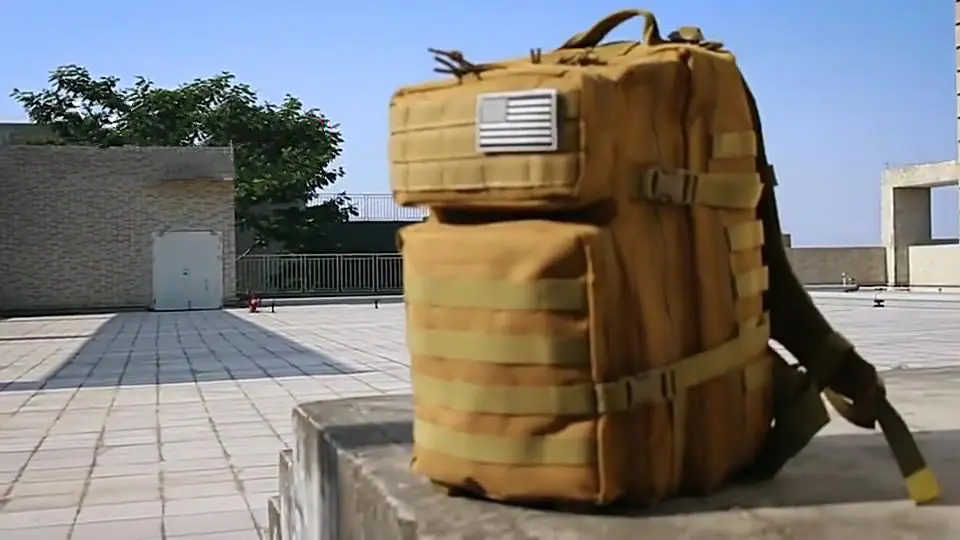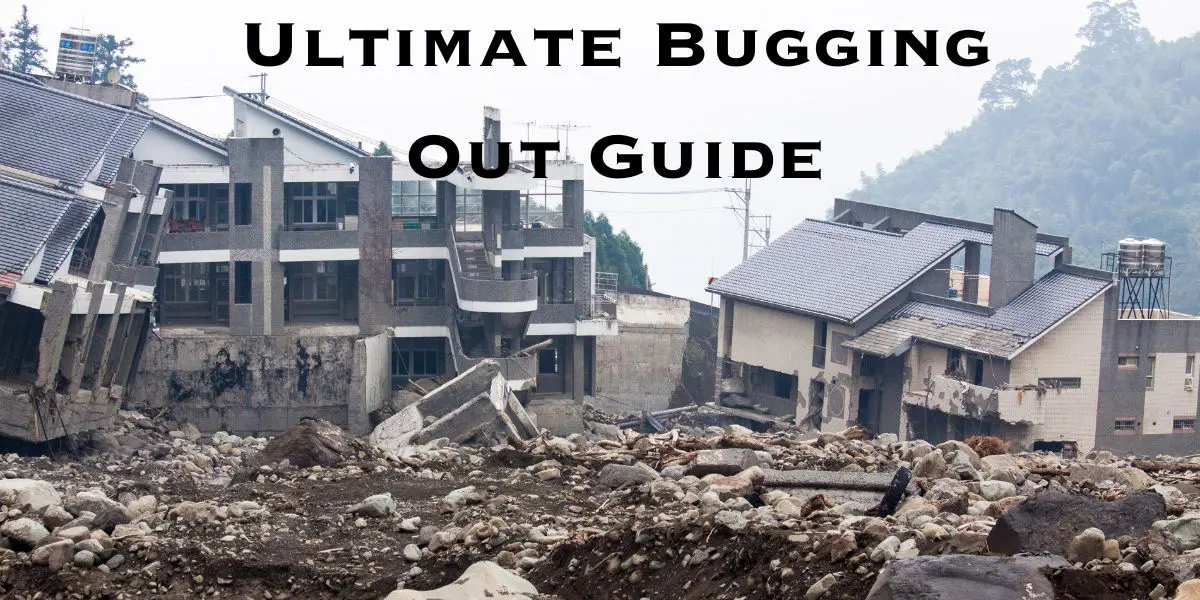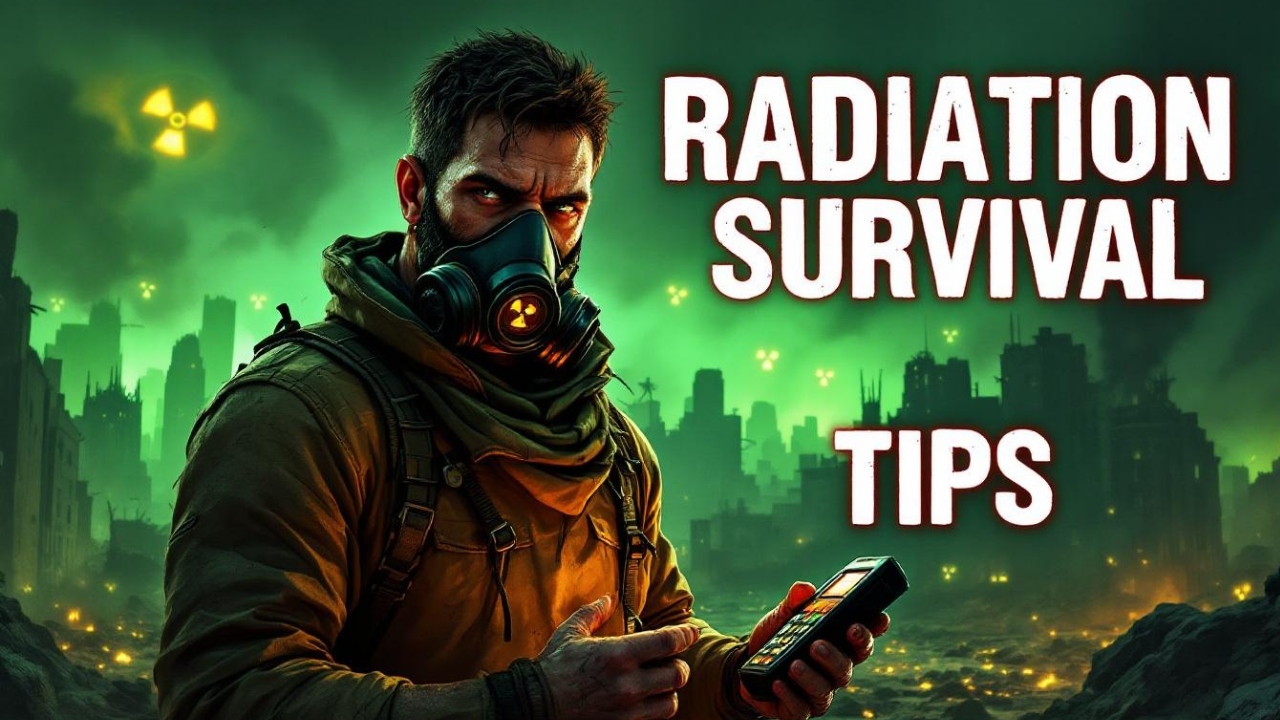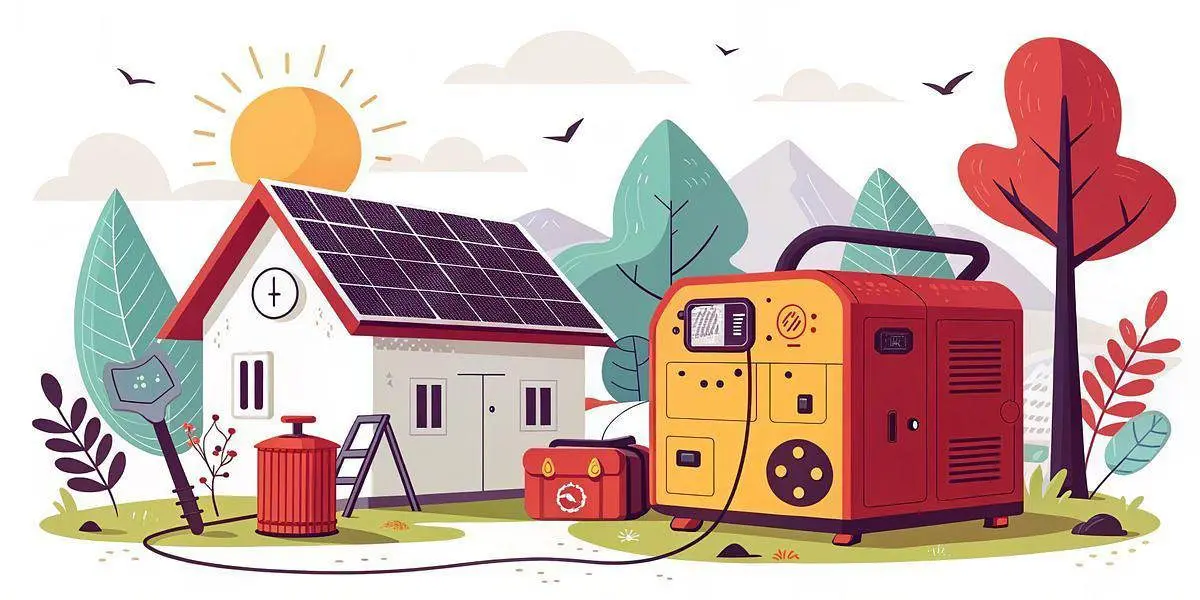How to Prepare for Emergency Evacuation – A Comprehensive Guide
Introduction To Bugging Out
Bugging out is a term commonly used among preppers to describe the act of leaving one’s home or current location in the event of an emergency or disaster. It involves evacuating to a safer location where basic needs can be met and the risk of danger is minimized. While bugging out may not always be necessary, it is an important consideration for preppers who prioritize being prepared for any situation.
The purpose of this article is to provide a comprehensive guide on how to prepare for emergency evacuation. We understand the importance of having a well-thought-out plan in place, as it can mean the difference between life and death in a crisis. By following the steps outlined in this guide, you will be better equipped to handle an emergency evacuation and ensure the safety of yourself and your loved ones.
Why Bugging Out is Important
Before diving into the details of how to prepare for emergency evacuation, it is crucial to understand why bugging out is important for preppers. Here are a few key reasons:
- Increased Safety: Bugging out allows you to escape immediate danger and find a safer location. This could be due to natural disasters, civil unrest, or any other emergency situation that poses a threat to your well-being.
- Preservation of Resources: By leaving your home and relocating to a designated bug-out location, you can conserve essential resources such as food, water, and medical supplies. This ensures that you have enough provisions to sustain yourself and your family during the crisis. This is based on the premise that you would lose those resources by staying in place (ie. a natural disaster, home takeover, etc..)
- Flexibility: Bugging out provides you with the flexibility to adapt to changing circumstances. It allows you to assess the situation and make informed decisions based on the evolving nature of the emergency.
- Avoiding Gridlock: In the event of a widespread disaster, roads and highways can quickly become congested, making it difficult to travel. By bugging out early, you can avoid getting stuck in traffic and reach your bug-out location more efficiently.
Preparing for Emergency Evacuation
Now that we understand the importance of bugging out, let’s delve into the steps you can take to prepare for emergency evacuation:
1. Create a Bug-Out Plan
The first step in preparing for emergency evacuation is to create a detailed bug-out plan. This plan should outline the following:
| Key Elements of a Bug-Out Plan | Description |
|---|---|
| Designated Bug-Out Location | Identify a safe location where you and your family can retreat to in the event of an emergency. This could be a friend or family member’s house, a remote cabin, or a designated bug-out shelter. |
| Evacuation Routes | Map out multiple evacuation routes from your home to the bug-out location. Consider alternative routes in case certain roads are blocked or inaccessible. |
| Communication Plan | Establish a communication plan with your family members or bug-out group. Determine how you will stay in touch during an emergency and designate a meeting point if you get separated. |
| Emergency Supplies | Compile a list of essential emergency supplies that you will need to take with you when bugging out. This includes food, water, clothing, first aid kits, and any other necessary items. |
By creating a comprehensive bug-out plan, you will have a clear roadmap to follow during an emergency evacuation. Regularly review and update your plan to ensure its effectiveness.
2. Assemble an Emergency Kit
In addition to having a bug-out plan, it is essential to assemble an emergency kit that contains all the necessary supplies for survival. Here are some key items to include:
- Non-perishable food items
- Bottled water
- First aid supplies
- Flashlights and extra batteries
- Emergency blankets
- Personal hygiene products
- Multi-tool
- Extra clothing and sturdy footwear
- Important documents (identification, insurance papers, etc.)
Make sure to regularly check and replenish your emergency kit to ensure that all items are in good condition and within their expiration dates.
3. Learn Basic Survival Skills
Having basic survival skills can greatly increase your chances of survival during an emergency evacuation. Consider learning the following skills:
- Fire starting techniques
- Navigation and map reading
- First aid and CPR
- Water purification methods
- Shelter building
Practice these skills regularly to build confidence and proficiency. You can attend survival courses or workshops to further enhance your knowledge.
4. Stay Informed
Stay informed about potential threats and emergencies in your area. Sign up for emergency alerts and notifications from local authorities. Keep a battery-powered radio or a hand-cranked radio to stay updated on the latest news and instructions during an evacuation.
Additionally, familiarize yourself with the emergency evacuation plans and procedures of your community. This will help you understand the protocols to follow and the resources available to you.
5. Conduct Practice Drills
Regularly conduct practice drills to test your bug-out plan and emergency preparedness. This will help identify any gaps or areas that need improvement. Practice assembling your emergency kit, evacuating your home, and reaching your bug-out location within a specified time frame.
By practicing these drills, you will be better prepared to handle the stress and challenges that may arise during an actual emergency evacuation.
Remember, preparation is key when it comes to emergency evacuation. By following these steps and being proactive in your preparedness efforts, you can ensure the safety and well-being of yourself and your loved ones in times of crisis.
How to Prepare for Emergency Evacuation – A Comprehensive Guide
How to Prepare for Emergency Evacuation – A Comprehensive Guide
Section 1: Assessing the Situation
Before making the decision to bug out, it is crucial to assess the situation and determine whether evacuation is necessary. This step is important as it helps you make an informed choice based on the specific circumstances at hand. Here’s why assessing the situation is vital:
Importance of Assessing the Situation
Assessing the situation allows you to gather relevant information and evaluate the level of risk or danger posed by the emergency. By understanding the severity and scope of the situation, you can make a well-informed decision on whether to stay or evacuate. This assessment helps you prioritize your safety and the safety of your loved ones.
Types of Emergencies Requiring Evacuation
There are various types of emergencies that may necessitate evacuation. These include:
| Type of Emergency | Description |
|---|---|
| Natural Disasters | Events such as hurricanes, floods, wildfires, earthquakes, or severe storms can pose a significant threat to life and property. Evacuation may be necessary to escape the immediate danger and find shelter in a safer location. |
| Industrial Accidents | In the event of a chemical spill, explosion, or other industrial accidents, authorities may issue evacuation orders to protect the public from hazardous materials or potential harm. |
| Terrorist Attacks | In situations involving terrorist attacks or acts of violence, evacuation may be necessary to remove individuals from the immediate danger zone and ensure their safety. |
| Civil Unrest | During times of civil unrest, such as riots or protests, bugging out may be necessary to avoid potential violence, looting, or other dangerous situations. |
These are just a few examples of emergencies that may require evacuation. It is important to stay informed about potential threats in your area and follow the guidance of local authorities.
Examples of Situations Requiring Bugging Out
While every emergency situation is unique, there are certain scenarios where bugging out would be necessary. Here are a few examples:
- Approaching Natural Disaster: If you receive official warnings of an impending natural disaster, such as a hurricane or wildfire, it is crucial to evacuate to a safer location. These events can cause widespread destruction and pose a significant risk to life.
- Chemical Spill: In the event of a chemical spill or release of hazardous materials in your vicinity, authorities may issue evacuation orders to protect residents from potential health hazards.
- Unstable Infrastructure: If the infrastructure in your area becomes compromised, such as a bridge collapse or a major power outage, it may be necessary to evacuate to a location with more stable resources and services.
- Imminent Threat: If there is an imminent threat to your safety, such as an active shooter situation or a terrorist attack, it is crucial to evacuate to a secure location away from the danger.
Remember, each situation is unique, and the decision to bug out should be based on a careful assessment of the specific circumstances and guidance from local authorities.

How to Prepare for Emergency Evacuation – A Comprehensive Guide
Section 2: Creating a Bug Out Plan
Creating a bug out plan is a crucial step in preparing for emergency evacuation. It involves carefully considering various factors and making important decisions to ensure a smooth and safe evacuation. Here’s how you can create an effective bug out plan:
Steps to Create a Bug Out Plan
Follow these steps to create a comprehensive bug out plan:
- Identify a Designated Bug Out Location: Choose a safe location where you and your family can retreat to in the event of an emergency. This could be a friend or family member’s house outside the affected area, a remote cabin, or a designated bug-out shelter. Ensure that the location is easily accessible and has the necessary resources to sustain you during the crisis.
- Map Out Multiple Evacuation Routes: Identify and map out multiple evacuation routes from your home to the bug out location. Consider alternative routes in case certain roads are blocked or inaccessible. Familiarize yourself with these routes and ensure that everyone in your family knows how to navigate them.
- Establish a Communication Plan: Establish a communication plan with your family members or bug-out group. Determine how you will stay in touch during an emergency and designate a meeting point if you get separated. It is important to have a reliable means of communication, such as walkie-talkies or designated phone numbers, to ensure everyone’s safety.
- Compile Essential Emergency Supplies: Make a list of essential emergency supplies that you will need to take with you when bugging out. This includes food, water, clothing, first aid kits, tools, and any other necessary items. Pack these supplies in easily transportable containers or backpacks for quick and efficient evacuation.
Importance of Multiple Evacuation Routes
Having multiple evacuation routes is crucial for several reasons:
- Flexibility: Multiple routes provide flexibility in case certain roads are blocked or congested. This allows you to adapt to changing circumstances and find the most efficient way to reach your bug out location.
- Avoiding Danger Zones: Different routes may help you avoid potential danger zones or areas with high levels of congestion. By having alternative options, you can minimize the risk of encountering hazards during evacuation.
- Accounting for Road Conditions: Road conditions can vary during emergencies, such as flooding or landslides. Having multiple routes ensures that you can navigate around these obstacles and reach your destination safely.
When mapping out your evacuation routes, consider factors such as traffic patterns, road conditions, and potential bottlenecks. Regularly review and update your routes to account for any changes in the area.
Tips for Selecting a Bug Out Location
When selecting a bug out location, consider the following tips:
- Distance from Potential Threats: Choose a bug out location that is a safe distance away from potential threats, such as flood-prone areas, industrial sites, or densely populated urban areas.
- Availability of Resources: Ensure that the bug out location has access to essential resources such as water, food, and shelter. Consider the availability of natural resources, such as nearby water sources or fertile land for growing food.
- Security and Privacy: Look for a bug out location that offers security and privacy. This could include properties with natural barriers, remote locations, or properties with security features.
- Community Support: Consider the presence of a supportive community in the bug out location. Having neighbors or like-minded individuals who can provide assistance and support during an emergency can be invaluable.
Remember, selecting a bug out location is a personal decision that should align with your specific needs and circumstances. Take the time to research and visit potential locations to ensure they meet your requirements.

How to Prepare for Emergency Evacuation – A Comprehensive Guide
Section 3: Assembling a Bug Out Bag
Assembling a bug out bag is a critical step in preparing for emergency evacuation. A bug out bag, also known as a go bag or 72-hour kit, is a portable kit that contains essential items to sustain you and your family for at least 72 hours during an emergency. Here’s what you need to know about assembling a bug out bag:
Purpose of a Bug Out Bag
A bug out bag serves several important purposes:
- Emergency Preparedness: A bug out bag ensures that you have essential supplies readily available in case of an emergency. It provides you with the necessary tools and resources to survive and stay comfortable during the initial critical hours or days of an evacuation.
- Portability and Mobility: A bug out bag is designed to be portable and easy to carry. It allows you to quickly grab your essential items and evacuate to a safer location without being weighed down by heavy or bulky equipment.
- Self-Reliance: By assembling a bug out bag, you are taking proactive steps to be self-reliant during an emergency. It ensures that you have the necessary supplies to meet your basic needs, even if access to external resources is limited.
Essential Items for a Bug Out Bag
When assembling a bug out bag, include the following essential items:
| Category | Items |
|---|---|
| Food and Water | Non-perishable food items, water bottles or water purification tablets, and a portable water filter. |
| Shelter and Clothing | Tent or tarp, sleeping bag or emergency blanket, extra clothing, sturdy footwear, and rain gear. |
| First Aid and Medications | First aid kit, prescription medications, over-the-counter medications, and any necessary medical supplies. |
| Tools and Equipment | Multi-tool, flashlight or headlamp with extra batteries, fire starter, whistle, duct tape, and a small portable stove. |
| Communication and Navigation | Cell phone with a portable charger, a hand-cranked or battery-powered radio, a compass, and a map of the area. |
| Personal Hygiene and Sanitation | Toilet paper, hand sanitizer, wet wipes, menstrual products, and any necessary personal hygiene items. For an effective approach to packing hygiene items in your bug out bag, consider referring to this guide on the world’s smallest bugout bag hygiene pack which offers valuable insights. |
| Important Documents | Copies of identification documents, insurance papers, emergency contact information, and any other important documents. |
Remember to customize your bug out bag based on your specific needs, such as any unique medical conditions or dietary restrictions. Additionally, consider the needs of other family members, including infants, children, or pets.
Importance of Regularly Updating and Maintaining the Bug Out Bag
Regularly updating and maintaining your bug out bag is essential to ensure its effectiveness. Here’s why:
- Expiration Dates: Check the expiration dates of food, water, medications, and other perishable items in your bug out bag. Replace any expired items to ensure their freshness and effectiveness.
- Seasonal Considerations: Update your bug out bag based on seasonal changes. For example, include appropriate clothing and gear for cold weather during winter months or additional water and sun protection during hot summer months.
- Changing Needs: As your circumstances change, such as the addition of a new family member or a change in medical conditions, update your bug out bag to accommodate these changing needs.
- Regular Inspections: Regularly inspect your bug out bag for any damage or wear and tear. Replace or repair any damaged items to ensure their functionality when needed.
Set a reminder to review and update your bug out bag at least once a year or whenever there are significant changes in your life or circumstances.

How to Prepare for Emergency Evacuation – A Comprehensive Guide
Section 4: Securing Shelter and Resources
Securing shelter and resources is a crucial aspect of emergency evacuation preparedness. During an evacuation, finding suitable shelter and ensuring access to necessary resources such as food, water, and medical supplies are essential for your safety and well-being. Here’s what you need to know:
Importance of Securing Shelter
Securing shelter during an emergency evacuation is of utmost importance. Here’s why:
- Protection from the Elements: Shelter provides protection from extreme weather conditions, such as rain, snow, or extreme heat. It helps keep you safe and comfortable during the evacuation period.
- Privacy and Security: Having a secure shelter ensures your privacy and protects you from potential threats or intruders. It provides a safe space where you can rest and regroup during the crisis.
- Psychological Comfort: A shelter provides a sense of stability and familiarity during uncertain times. It helps reduce stress and anxiety, allowing you to focus on your well-being and decision-making.
Tips for Finding Suitable Shelter Options
When seeking shelter during an emergency evacuation, consider the following tips:
- Pre-Identify Potential Shelter Locations: Research and identify potential shelter locations in advance. This could include hotels, emergency shelters, campgrounds, or the homes of friends or family members outside the affected area.
- Consider Safety and Accessibility: Choose a shelter location that is safe and easily accessible. Avoid areas prone to flooding, landslides, or other natural hazards. Ensure that the shelter is within a reasonable distance from your current location.
- Assess Available Resources: Evaluate the resources available at the shelter, such as food, water, medical facilities, and sanitation facilities. Consider the capacity of the shelter and whether it can accommodate your specific needs.
- Communicate and Coordinate: Stay informed about available shelter options through local authorities or emergency management agencies. Follow their instructions and communicate with your family or bug-out group to ensure everyone is aware of the designated shelter location.
Importance of Securing Necessary Resources
Securing necessary resources such as food, water, and medical supplies is vital during an emergency evacuation. Here’s why:
- Sustenance and Hydration: Adequate food and water supplies ensure that you have the necessary sustenance and hydration to stay healthy and energized during the evacuation period.
- Medical Needs: Having essential medical supplies and medications on hand is crucial, especially for individuals with pre-existing medical conditions. It allows you to manage any existing health conditions and address minor injuries or illnesses during the evacuation.
- Self-Sufficiency: By securing necessary resources, you reduce your reliance on external assistance and increase your self-sufficiency during the evacuation. This ensures that you can sustain yourself and your family until additional help or resources become available.
When securing necessary resources, consider the duration of the evacuation and the specific needs of your family members. Stock up on non-perishable food items, bottled water, first aid supplies, prescription medications, and any other essential items that you may require.

How to Prepare for Emergency Evacuation – A Comprehensive Guide
Section 5: Communication and Navigation
Communication and navigation are crucial aspects of emergency evacuation preparedness. During an evacuation, having reliable communication devices and the ability to navigate unfamiliar areas can greatly enhance your safety and chances of reaching your desired destination. Here’s what you need to know:
Significance of Communication and Navigation
Communication and navigation play vital roles during an emergency evacuation. Here’s why they are significant:
- Staying Informed: Reliable communication devices allow you to stay informed about the latest updates, warnings, and instructions from local authorities. This information is crucial for making informed decisions and ensuring your safety.
- Coordination and Reunification: Communication devices enable you to coordinate with your family members or bug-out group during an evacuation. They help you stay connected and facilitate reunification if you get separated.
- Emergency Assistance: In case of an emergency or if you require assistance, reliable communication devices allow you to reach out for help and communicate your location or specific needs to emergency services.
- Navigation and Route Planning: Navigational tools such as maps, compasses, or GPS devices help you navigate unfamiliar areas and find the most efficient routes to your bug-out location. They prevent you from getting lost and wasting valuable time and resources.
Importance of Reliable Communication Devices
Having reliable communication devices is essential during an emergency evacuation. Here’s why:
- Cell Phones: Cell phones are valuable communication tools, providing the ability to make calls, send text messages, and access the internet for information. Ensure your cell phone is fully charged and consider having a portable charger or power bank as a backup.
- Two-Way Radios: Two-way radios, also known as walkie-talkies, are useful for short-range communication within your bug-out group or with nearby individuals. They do not rely on cellular networks and can be a reliable means of communication in areas with limited or no cell service.
- Emergency Radio: A hand-cranked or battery-powered emergency radio allows you to stay updated on the latest news, weather updates, and emergency alerts. It provides valuable information even when other communication channels are unavailable.
Ensure that your communication devices are in good working condition, have sufficient battery life, and are stored in a waterproof and easily accessible location within your bug-out bag.
Tips for Navigating Unfamiliar Areas
Navigating unfamiliar areas during an emergency evacuation can be challenging. Here are some tips to help you navigate effectively:
- Plan Ahead: Before an emergency occurs, familiarize yourself with maps of your local area and potential evacuation routes. Identify landmarks, major roads, and alternative routes to your bug-out location.
- Use Navigational Tools: Carry essential navigational tools such as maps, compasses, or GPS devices. These tools can help you determine your location, orient yourself, and find the most efficient routes to your destination.
- Pay Attention to Landmarks: Take note of prominent landmarks or distinctive features along your route. These can serve as reference points and help you stay on track, even in unfamiliar surroundings.
- Stay Alert and Observant: Pay attention to road signs, street names, and any available signage that can guide you. Observe your surroundings and look for familiar landmarks or recognizable features to confirm your location.
Remember, staying calm and focused during navigation is essential. If you feel lost or unsure, don’t hesitate to ask for directions or seek assistance from local authorities or individuals who may be able to help.

How to Prepare for Emergency Evacuation – A Comprehensive Guide
Section 6: Maintaining Personal Safety
Maintaining personal safety is paramount during an emergency evacuation. Your well-being and the well-being of your loved ones should be a top priority. Here’s what you need to know about staying safe during an evacuation:
Importance of Personal Safety
Personal safety is of utmost importance during an emergency evacuation. Here’s why it matters:
- Physical Well-being: Prioritizing personal safety ensures that you and your loved ones remain physically unharmed during the evacuation. It helps prevent injuries, accidents, or exposure to dangerous situations.
- Emotional Well-being: Feeling safe and secure during an emergency evacuation reduces stress, anxiety, and fear. It allows you to think clearly, make rational decisions, and support the well-being of those around you.
- Preventing Crime and Exploitation: Personal safety measures help protect you from potential criminal activities or exploitation that may occur during chaotic situations. It minimizes the risk of becoming a target for theft, violence, or scams.
Tips for Staying Safe While Bugging Out
Follow these tips to ensure your personal safety during an emergency evacuation:
- Stay Informed: Stay updated on the latest information and instructions from local authorities. Follow their guidance and adhere to any evacuation orders or safety protocols.
- Travel in Groups: Whenever possible, travel with a group of trusted individuals. There is safety in numbers, and traveling together can deter potential threats and provide support and assistance to one another.
- Be Aware of Your Surroundings: Stay vigilant and observant of your surroundings. Pay attention to any potential hazards, suspicious activities, or individuals who may pose a threat. Trust your instincts and take necessary precautions.
- Secure Your Belongings: Keep your belongings secure and within your sight at all times. Use locks or secure containers to protect valuable items. Avoid displaying expensive or flashy possessions that may attract unwanted attention.
- Practice Self-Defense: Consider learning basic self-defense techniques to protect yourself and your loved ones. This can include simple moves to escape from grabs or understanding how to use personal safety devices such as pepper spray or personal alarms. AND OF COURSE Learn and become proficient with firearms.
Importance of Self-Defense and Basic First Aid Knowledge
Having self-defense and basic first aid knowledge is crucial during an emergency evacuation. Here’s why:
- Self-Defense: Self-defense knowledge empowers you to protect yourself and others in potentially dangerous situations. It provides you with the skills and confidence to respond effectively and escape from threatening encounters.
- Basic First Aid: Basic first aid knowledge allows you to provide immediate medical assistance to yourself or others in case of injuries or medical emergencies. It can help stabilize a condition until professional medical help arrives.
Consider taking Firearms and self-defense classes and basic first aid courses to enhance your knowledge and skills. These courses are widely available and can provide valuable life-saving techniques.

How to Prepare for Emergency Evacuation – A Comprehensive Guide
Section 7: Reaching the Bug Out Location
Reaching the bug out location is the ultimate goal of an emergency evacuation. It is crucial to follow the necessary steps and remain calm and focused throughout the process. Here’s what you need to know:
Steps to Reach the Bug Out Location
Follow these steps to ensure a successful journey to your bug out location:
- Activate Your Bug Out Plan: As soon as you receive the evacuation order or determine that it is necessary to bug out, activate your bug out plan. Gather your bug out bag, essential supplies, and any necessary equipment.
- Follow Designated Evacuation Routes: Stick to the designated evacuation routes outlined in your bug out plan. These routes have been carefully planned to ensure the safest and most efficient path to your bug out location.
- Stay Informed: Continuously monitor the latest updates and information from local authorities. Be aware of any road closures, traffic congestion, or potential hazards along your route.
- Adapt to Changing Conditions: Be prepared to adapt to changing conditions and adjust your route if necessary. Road closures, accidents, or other unforeseen circumstances may require you to take alternative routes to reach your destination.
- Stay Calm and Focused: Maintain a calm and focused mindset throughout the evacuation. Keep your emotions in check and make rational decisions based on the information available to you.
- Follow Traffic Laws and Regulations: Observe all traffic laws and regulations during the evacuation. Drive safely, maintain a safe distance from other vehicles, and avoid reckless behavior that could endanger yourself or others.
- Be Prepared for Obstacles: Anticipate potential obstacles or challenges along the way, such as roadblocks, detours, or congested areas. Stay patient and flexible, and be prepared to navigate around these obstacles.
- Communicate and Coordinate: Maintain communication with your bug-out group or family members throughout the journey. Update them on your progress and any changes in your route or estimated arrival time.
Importance of Staying Calm and Focused
Staying calm and focused is crucial during an emergency evacuation. Here’s why:
- Clear Decision-Making: A calm and focused mindset allows you to make clear and rational decisions during stressful situations. It helps you assess risks, evaluate options, and choose the best course of action.
- Reduced Stress and Anxiety: By staying calm, you can reduce stress and anxiety levels, which can impair your ability to think clearly and react effectively. It allows you to maintain a level-headed approach to the evacuation process.
- Positive Influence: Your calm demeanor can have a positive influence on those around you, especially family members or bug-out group members. It helps create a sense of stability and reassurance during a potentially chaotic situation.
Tips for Dealing with Potential Obstacles and Challenges
During an emergency evacuation, you may encounter various obstacles and challenges. Here are some tips to help you navigate through them:
- Stay Informed: Continuously stay informed about the latest road conditions, traffic updates, and potential hazards. Use reliable sources such as local news or traffic apps to gather real-time information.
- Have Alternative Routes: Plan and familiarize yourself with alternative routes to your bug out location. This allows you to navigate around road closures, accidents, or congested areas.
- Be Patient and Flexible: Expect delays and be patient during the evacuation. Traffic congestion or unexpected obstacles may slow down your progress. Stay flexible and adapt your plans accordingly.
- Use Navigation Tools: Utilize navigation tools such as GPS devices or smartphone apps to help you navigate unfamiliar areas or find alternative routes.
- Stay Focused on Safety: Prioritize safety above all else. Avoid taking unnecessary risks or engaging in aggressive driving behaviors. Your safety and the safety of your loved ones should always be the top priority.

How to Prepare for Emergency Evacuation – A Comprehensive Guide
Section 8: After Reaching the Bug Out Location
After reaching the bug out location, there are important actions to take to ensure your safety and well-being. It is crucial to set up a temporary shelter, secure the area, and assess the situation to adapt your bug out plan if necessary. Here’s what you need to know:
Actions to Take After Reaching the Bug Out Location
After reaching the bug out location, follow these actions to establish a safe and secure environment:
- Set Up a Temporary Shelter: Assemble your tent, tarp, or other temporary shelter to provide protection from the elements. Ensure that the shelter is secure and offers adequate space for you and your family members.
- Secure the Area: Assess the surroundings and identify potential security risks. Take measures to secure the area, such as setting up perimeter alarms, establishing a watch schedule, or fortifying entry points to deter unauthorized access.
- Organize Essential Supplies: Unpack and organize your bug out bag and essential supplies. Ensure that food, water, and medical supplies are easily accessible and properly stored to maintain their freshness and effectiveness.
- Establish Basic Amenities: Set up basic amenities such as a cooking area, sanitation facilities, and a designated area for waste disposal. Follow proper hygiene practices to maintain cleanliness and prevent the spread of diseases.
- Assess the Situation: Evaluate the current situation and compare it to your bug out plan. Consider any changes or new information that may require adjustments to your plan. Stay informed about the latest updates and developments.
- Adapt the Bug Out Plan: If necessary, adapt your bug out plan based on the assessed situation. This may involve revising evacuation routes, updating communication protocols, or making changes to resource management strategies.
Tips for Setting Up a Temporary Shelter and Securing the Area
Follow these tips to effectively set up a temporary shelter and secure the area:
- Choose a Suitable Location: Select a location for your temporary shelter that offers natural protection, such as under a tree canopy or against a natural barrier. Avoid areas prone to flooding, landslides, or other potential hazards.
- Consider Concealment: If possible, choose a location that provides natural concealment from potential threats. This can help maintain a low profile and reduce the risk of attracting unwanted attention.
- Use Camouflage Techniques: Employ camouflage techniques to blend in with the surroundings and make your shelter less visible. Use natural materials or camouflage tarps to help conceal your presence.
- Establish Perimeter Security: Set up perimeter alarms or tripwires to alert you of any potential intrusions. Consider using noise-making devices or motion-activated lights to deter unauthorized access.
- Maintain a Low Profile: Minimize noise, light, and other activities that could draw attention to your location. Keep conversations and movements discreet to avoid attracting unwanted attention.
Importance of Assessing the Situation and Adapting the Bug Out Plan
Assessing the situation and adapting your bug out plan is crucial for your continued safety and well-being. Here’s why it matters:
- Changing Circumstances: The situation may evolve or new information may emerge after reaching the bug out location. Assessing the situation allows you to make informed decisions based on the most up-to-date information available.
- Resource Management: Assessing the situation helps you evaluate the availability of resources and adjust your resource management strategies accordingly. This ensures that essential supplies are utilized effectively and sustainably.
- Communication and Coordination: Adapting the bug out plan based on the assessed situation allows you to update communication protocols and coordinate with other members of your bug-out group or family. This ensures effective communication and collaboration during the evacuation.

How to Prepare for Emergency Evacuation – A Comprehensive Guide
Frequently Asked Questions (FAQ)
1. What should I do if I don’t have a bug out location?
If you don’t have a designated bug out location, there are still steps you can take to ensure your safety during an emergency evacuation:
- Identify Temporary Shelter Options: Research and identify potential temporary shelter options in your area, such as emergency shelters, community centers, or hotels. These locations can provide a safe place to stay until it is safe to return home or find a more permanent solution.
- Reach Out to Friends and Family: Contact friends or family members who may be located outside the affected area and inquire about the possibility of staying with them temporarily. Having a support network can provide both physical and emotional support during a crisis.
- Consider Alternative Housing Options: Explore alternative housing options such as renting a cabin, utilizing a recreational vehicle (RV), or even camping in designated areas. These options can provide temporary shelter and protection during an emergency.
2. How often should I update my bug out bag?
It is important to regularly update your bug out bag to ensure that the contents are fresh, functional, and aligned with your current needs. Here are some guidelines:
- Check Expiration Dates: Regularly check the expiration dates of food, water, medications, and other perishable items in your bug out bag. Replace any expired items to maintain their freshness and effectiveness.
- Review Seasonal Needs: Consider the changing seasons and update your bug out bag accordingly. For example, include appropriate clothing and gear for cold weather during winter months or additional water and sun protection during hot summer months.
- Assess Personal Needs: Regularly assess your personal needs and make adjustments to your bug out bag. This may include adding specific medications, personal hygiene items, or other essentials based on your individual requirements.
- Inspect and Maintain: Regularly inspect your bug out bag for any damage or wear and tear. Replace or repair any damaged items to ensure their functionality when needed.
3. Can I bug out alone or should I have a group?
Both options have their advantages and considerations. Whether you choose to bug out alone or with a group depends on various factors, including your skills, resources, and the specific situation. Here are some points to consider:
- Bugging Out Alone: Bugging out alone allows for greater mobility, flexibility, and decision-making autonomy. It can be advantageous if you have the necessary skills, knowledge, and resources to navigate and survive on your own. However, it also means you are solely responsible for your safety and well-being.
- Bugging Out with a Group: Bugging out with a group can provide additional support, resources, and shared responsibilities. It allows for division of tasks, increased security, and emotional support during a crisis. However, it requires coordination, communication, and the ability to work together effectively.
Ultimately, the decision to bug out alone or with a group depends on your individual circumstances, capabilities, and preferences. It is important to assess your own skills, resources, and the specific situation to determine the best approach for your safety and well-being.
4. What should I do if I encounter dangerous individuals during bugging out?
Encountering dangerous individuals during an emergency evacuation can be a challenging situation. Here are some tips to help you handle such encounters:
- Stay Calm and Assess the Situation: Maintain a calm and composed demeanor. Assess the intentions and behavior of the individuals you encounter. Trust your instincts and be prepared to react accordingly.
- Keep a Low Profile: Avoid drawing unnecessary attention to yourself. Minimize noise, light, and other activities that could attract unwanted attention. Maintain a low profile to reduce the risk of becoming a target.
- Use Verbal De-escalation: If confronted, try to defuse the situation through calm and respectful communication. Avoid confrontation and aggression. Use clear and assertive language to assert your boundaries and intentions.
- Escape and Evade: If the situation escalates or you feel threatened, prioritize your safety and seek an opportunity to escape. Look for alternative routes or safe areas to retreat to. Avoid engaging in physical confrontations whenever possible.
- Seek Help and Report: If you encounter dangerous individuals, report the incident to the appropriate authorities as soon as it is safe to do so. Provide them with accurate information about the encounter to assist in their response and investigation.
5. How can I ensure the safety of my pets during an emergency evacuation?
Ensuring the safety of your pets during an emergency evacuation is important. Here are some tips to help you protect your furry companions:
- Include Pets in Your Emergency Plan: Plan ahead and include your pets in your emergency evacuation plan. Identify pet-friendly shelters, hotels, or accommodations in advance.
- Prepare a Pet Emergency Kit: Assemble a pet emergency kit that includes food, water, medications, leashes, collars, identification tags, and any other necessary supplies. Keep these items readily accessible.
- Secure Your Pets: Keep your pets securely leashed or in carriers during the evacuation process. This prevents them from getting lost or injured in unfamiliar surroundings.
- Ensure Proper Identification: Make sure your pets have proper identification tags with up-to-date contact information. Consider microchipping your pets as an additional form of identification.
- Comfort and Calm Your Pets: During the evacuation, provide comfort and reassurance to your pets. Keep them calm and secure, as they may be stressed or anxious during the process.
Remember, your pets rely on you for their safety and well-being. By including them in your emergency plans and taking necessary precautions, you can ensure their safety during an evacuation.






























